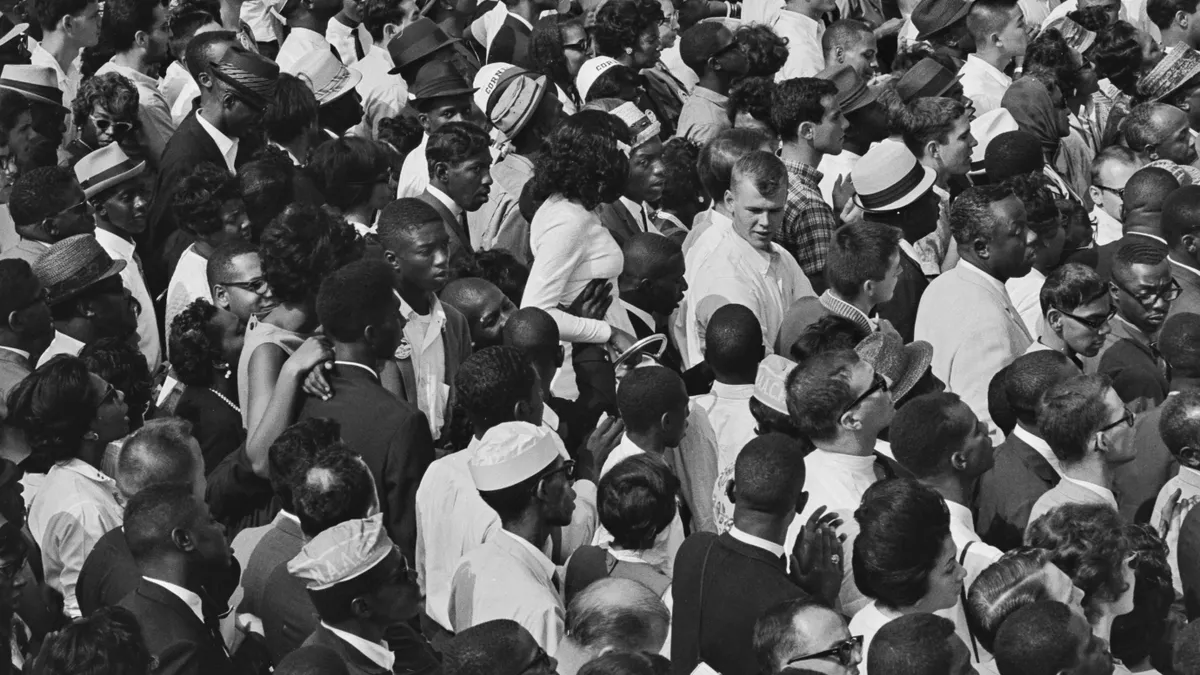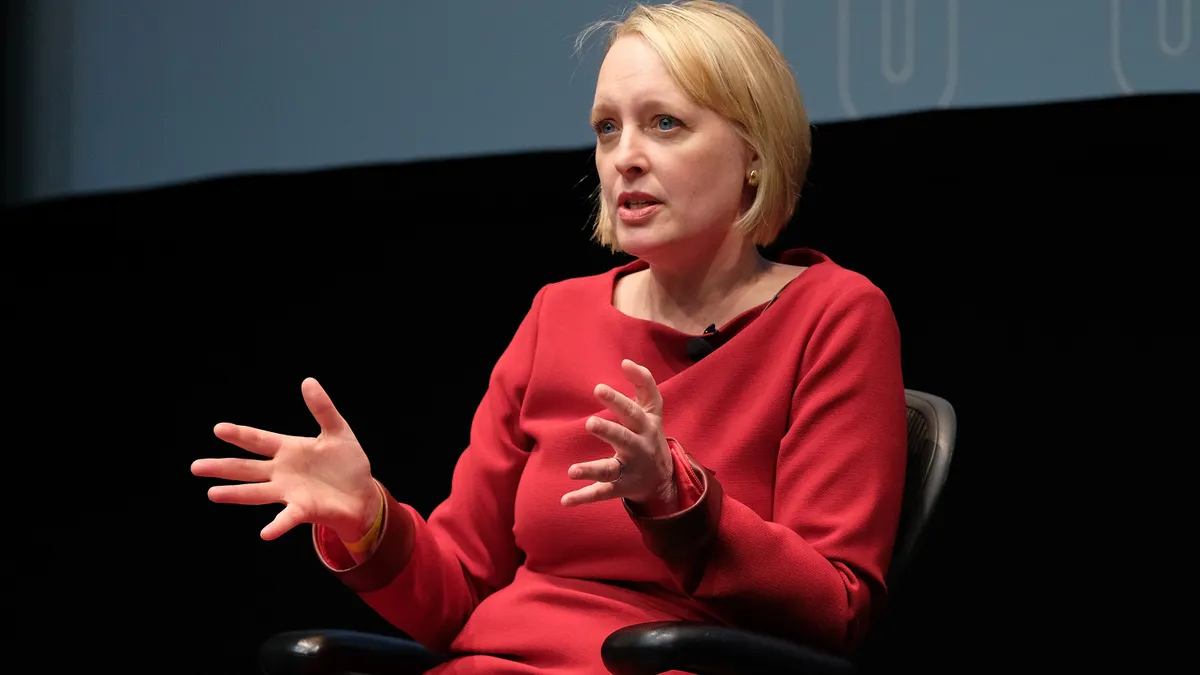Title VII of the Civil Rights Act of 1964 — a mainstay of U.S. employment law — celebrates its 60th anniversary week. But the path to passage wasn’t smooth, and its time on the books has been just as winding.
And Gwendolyn Young Reams, acting general counsel of the U.S. Equal Employment Opportunity Commission, has been there from nearly the beginning.
1963: Marching toward Washington, D.C.
When the March on Washington for Jobs and Freedom happened in 1963, Reams was a teenager living in Charleston, South Carolina — a circumstance that inspired FOMO.
“I was still in high school when they had the March on Washington and I remember being so, so jealous,” Reams said. As one of six children and someone born to parents who owned a brick-and-mortar business and a farm, making the trek to Washington, D.C., would have proved challenging.
Still, Reams was excited; she already had civic engagement on her mind. “I am a child of the civil rights movement,” Reams proclaimed. Not only was she very aware of the NAACP’s work at the time, but President John F. Kennedy’s campaign also stood out.
“It was the first time I really saw how engaged Black people were in our church and our community — you know, how excited they were and how hopeful we were about this particular president,” she said.
By the fall of 1964, she had traded the Lowcountry for the nation’s capital as a freshman at Howard University. She knew she wanted to be a civil rights lawyer, so her search for a historically black college with a law school led her to “The Mecca.”
Ultimately, she earned her juris doctor from American University’s Washington College of Law. But her time at Howard only deepened her experience with the Civil Rights Movement. “My freshman or sophomore year at Howard, Martin Luther King Jr. stayed in the women’s dorm. Apparently, the women’s dorm was more set up for guests, with a guest suite,” she recalled. “The women’s dorm back in those days — you know, they had curfews and stuff,” she added, noting that the dorm was quite secure.
King had been visiting Howard since 1956; school historians note that in one lecture that took place on March 5, 1966, in Cramton Auditorium — when Reams was an undergrad — he called for an end to “racial injustice, poverty and war.” He also visited a few months later, repeating a previous lecture on nonviolence in the fight for racial justice.
Kwame Ture, formerly known as Stokely Carmichael, was also at Howard. Ture became a notable activist as a member of the Student Nonviolent Coordinating Committee and graduated from the school in 1964; he later participated in the Mississippi Summer Project to register Black voters.
“You name it, [they] came there,” Reams said.
1964: Getting the Act to the Capitol
Kennedy had long been vocal about his desire for every American to experience equal treatment, regardless of race. And civil rights advocates had been building momentum for some time.
Asian and Hispanic workers had notable, respective movements but Black workers’ rights advocates made a monumental impact — in both the American South and in Washington, D.C.
Some activists’ names come more easily than others, such as Martin Luther King Jr. and Malcolm X. The latter had a notable impact on Washington, D.C., at this buzzy time of civil rights: To this day, Meridian Hill Park colloquially bears the moniker “Malcolm X Park,” thanks to Angela Davis’ call to rename the space in homage to the Black activists who organized there.
But now other names emerge into the mainstream consciousness, as history is sifted for new perspectives. Bayard Rustin, a gay man and one of King’s closest collaborators, helped found the Southern Christian Leadership Conference and helped organize the March on Washington in 1963.
Rustin later continued his advocacy for Black workers as head of the American Federation of Labor and Congress of Industrial Organizations’ A. Philip Randolph Institute. Alongside Randolph himself, Rustin led this AFL-CIO contingent from 1965 to 1979.
Randolph was a legend in his own right: He founded and led the Brotherhood of Sleeping Car Porters, one of the first predominantly Black labor unions, in 1925. These porters were employees of the Pullman Company, one the largest employers of Black talent at the time. Randolph’s push to improve the working conditions, pay and treatment for this subsect of entry-level workers “contributed to the growth of the Black middle class,” according to Library of Congress business historians.
Following these activists’ efforts, politicians pushed for the Civil Rights Act to be passed. Opponents attempted to block its passage with a filibuster in the Senate. But by the time Congress came around to the vote on July 2, 1964, it passed 73 to 27, a bipartisan victory that led the Senate galleries to break out in applause, the Congressional Record says. President Lyndon B. Johnson signed the bill into law that same day.
1965: The EEOC opens up shop
The Civil Rights Act established the EEOC and the government wasted little time: On July 2, 1965, the EEOC opened its doors, getting off the ground with about 100 employees.
And Reams was there nearly from the beginning. “It was a special time to be in D.C. — maybe I just catch all the special times,” she said. “When I came to the EEOC, it was a special time, for sure.”
Still, she was skeptical about Title VII. “I thought it was definitely striking all the right tones, but I really wondered if it was just going to be another statute sitting on the books to make people feel better,” she said.
She arrived at EEOC the summer before her senior year. While waiting to hear back from the U.S. Department of Housing and Urban Development about an internship, a fellow AU grad clued Reams in to another opportunity: “She just said to me one day that EEOC needed another intern because someone who was supposed to come dropped out. She said, ‘You know, you oughta come on over here.’”
Reams applied, she said, and was hired immediately, noting that the EEOC paid interns even then.
“It was an exciting place,” she recalled. “They were writing guidance and regulations and having hearings around the country. And when I came here, they put me immediately on a working group that was looking into the discrimination against women and minorities over wages and promotions,” she said.
Reams has been at the agency ever since, officially brought on as an attorney in 1972. There, she would witness, embrace and enforce the expansion of the Civil Rights Act, and the legislation that followed: the Pregnancy Discrimination Act of 1978 (which filled what Reams viewed as a frustrating gap in Title VII), the Americans with Disabilities Act in 1990, the Civil Rights Act of 1991, the Lily Ledbetter Fair Pay Act of 2009 and ultimately the Pregnant Workers Fairness Act in 2023.
“I wondered if it was just going to be another statute sitting on the books to make people feel better.”

Gwendolyn Young Reams
Acting general counsel of the U.S. Equal Employment Opportunity Commission
In her decades with the agency, she has held several roles, including serving as executive assistant to the general counsel; a supervisor trial attorney; a systemic litigation trial attorney; an associate general counsel for appellate services and an associate general counsel for litigation management services.
She also has met many well-known civil rights attorneys: There was Judge Gabrielle Kirk McDonald, who worked as an attorney for the NAACP Legal Defense and Educational Fund in the ‘60s. McDonald later went on to be a federal judge for the U.S. District Court for the Southern District of Texas — the first Black person appointed to the bench in not just Texas, but the South, period. At the time, she was the third Black woman in the country to ever be a federal judge.
There was also McDonald’s colleague “Bill,” a.k.a. William Robinson, an early director of NAACP LDF’s discrimination practice. The 25 federal appellate cases his team won set a legal precedent said to have shaped many lawyers’ and claimants’ approach to filing Title VII suits.
“You just felt so lucky,” Reams said.
At one point, Reams thought about going to Atlanta, to more region-specific litigation work, she told HR Dive, but felt she could do her best work at the federal level. “It’s got to give me some kind of advantage or longevity; it definitely couldn’t hurt to have that with me,” Reams said she thought to herself at the time.
2021: A legacy of change
It was in 2021 that President Joe Biden appointed Reams to the acting general counsel seat; Charlotte Burrows, the EEOC’s chair, said at the time that she was “gratified” at Biden’s move.
“[Reams’] experience and proven leadership will provide stability and direction as the Commission implements its vigorous civil rights agenda,” she continued. And it has proven vigorous, with a 2022-2026 Strategic Enforcement Plan that has notably made “outreach to vulnerable workers and underserved communities” a top priority.
Human nature, with both its good and bad, persists — no matter what laws are on the books. It’s why Reams and others at the EEOC still have a job.
Title VII was “pivotal,” Reams said. “Fairness in employment is a basic human right, because it’s something that we need in order to live together in this society and be able to thrive as a family — and as part of a group, whether it’s a religion or a race or culture,” she continued. “That’s the basis of our economic structure.”
But it’s far from a static area of law. “[U]nfortunately, or fortunately, it'll be here quite a while and it’ll go through more change,” Reams said.
She emphasized the need for continued enforcement. “There are people who believe they should be treated better, because the less somebody else gets, the more they get — people with discriminatory views on who should be ‘the haves,’ who should be ‘the have-nots,’” she said. “And some of those people have companies, you know? And so, they just have to be taught in a rough way that [discrimination] is just not going to be accepted.”






















